1995.01.07
outline - long[est] axis
--the triumphant way as the start of the long axis.
--its extremes and the sexual connotations displayed by the buildings at the center of the long axis (Templum Martis) and the buildings at the two extremes of the axis (the two nympheums and the little intercourse building on the west bank of the Tiber).
1996.07.15
new insights - key to the language of plans
This note concerns my new insight into Piranesi's Campo Marzio. Eessentially I think I hit upon a substantial key concerning the language of the plans within the Campo Marzio. In retrospect, I think it was an understanding of Piranesi's plan language that I was interested in finding out from the very beginning--at least since I learned CAD.
The key to the language of plan forms starts with the long 'spiritual' axis of Mars and the tiny temple/shrine to the union of Mars and Rhea Silvia. I will not here go into the whole story of the long axis except to say that the Mars/Rhea Silvia shrine at the very end of the axis is the very basis of all the Piranesi plan forms. The plan of the shrine itself depicts, in simple planimetric form, the union of the male sex organ with the female sex organ. The plan is plain and simple, and where it not for its small size, would also be perceived as vulgar and blunt. Yet there is an essential beauty in its fertile simplicity--the notion of elementary plan forms is enhanced a thousand fold by the symbolism of outside vs. inside--gives it the power to spawn every other plan formation delineated.
The power and significance of the small shrine plan comes to the fore after an analysis of the second significant axis of the Campo Marzio--the Equiria. This axis represents the war/military aspect of Mars, and when compared with the long axis running through the altar to Mars, the Equiria, the race course, can be clearly considered the mundane axis (as opposed to the spiritual or sacred axis). The military character of the axis is quickly reinforced by the military offices and the military parade grounds that lie to the northern end of the Equiria. The fact that the Equiria is a horse race course also reinforces the mundane/military character of the axis, and this mundane aspect is most clearly manifest with the dirt road reality of the axis itself. (There may be the opportunity to call out a sacred vs. profane contrast between the two axes.)
Seeing how the first axis ends in sex, I was curious to see if the Equiria axis also ends in sex. While there is no building plan that explicitly depicts the co-joining of sexual organs, the north end of the axis has a pair of simple buildings--Vivaria Fulvii and Cochlearum Hirpini--made up of very few contiguous elements. I think this type of plan is the next step in the hierarchy after the sex temple. It is almost as if the sex temple starts something that quickly multiplies and mutates in the process. These two plans next to each other demonstrate the high order of symbolism in the first.
From the second order of plan, the next step up in the hierarchy is best exemplified by the sw Gymnasium on the Tiber and the Villa Publicus where the contiguous elements are still few yet numerously repeated, however there is a substantial addition of articulation in the individual contiguous pieces, especially in the carving out of space in the form of niches and thus heightening the issues of outside/inside, solid/void, figure/ground. This third type of plan formation is much more strongly related to the sex temple, yet the lesson of the second type of plan, the gemmation of a few parts, is a vital step in the evolutionary development of the plans. I wonder if I could here call it an embryonic development of the plan configuration. I also wonder if the second order of plan formation is to be considered profane vs. the sacred union of sex?
| |
1997.03.20
Exhibit 1 text
Life and Death within Piranesi's Ichnographia of the Campo Marzio
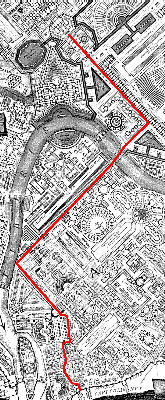
With a consistent dashed line, Piranesi demarcates the Triumphal Way through the Campo Marzio. The processional route begins, with historical and archeological accuracy, at the Templum Jani, which is situated at the bottom of the Ichnographia. The victor's march weaves through Rome's "theater district"--past small baths, shops, and brothels--and then continues on a long straight course towards the Tiber. Across the river, the procession turns behind the Sepulchrum Hadriani and approaches its end at the Templum Martis, the god of War and for whom the Campo Marzio is named. As the ultimate destination of the Triumphal Way, the Templum Martis is clearly among the most sacred, if not the most sacred, of places within the Campo Marzio, and, therefore, perhaps offers a key that lifts the Campo Marzio's "mask."
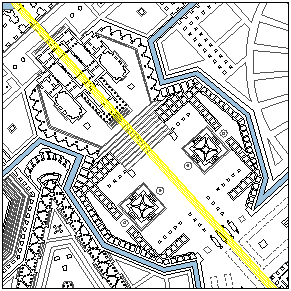
The Templum Martis fittingly promulgates overt manliness. Male genitalia boldly inform the Temple's plan, and the linear projection of the Temple's "endowment" manifests the Campo Marzio's longest straight axis.
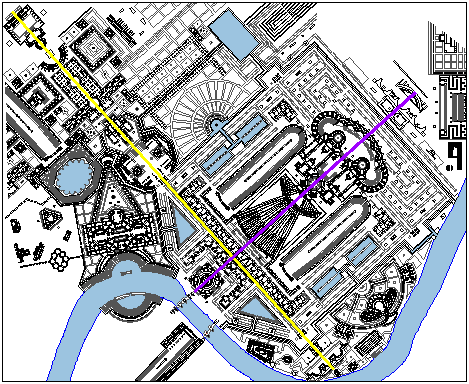
As the axis of Mars spans from the Vatican Hill to the bend in the Tiber, it intersects the Campo Marzio's second longest straight axis, which bisects Hadrian's Tomb and the Bustum Hadriani. The perpendicular crossing of the two axes naturally creates a diametrical opposition. Geometry alone, however, does not represent the depth of their oppositeness.
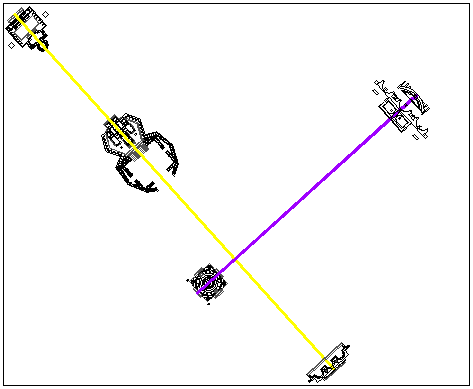
The axis of Mars terminates at either end with a nymphaeum, while the axis through the Bustum Hadriani terminates at either end with an Imperial Tomb. The antithesis of nymphaeums and tombs is self-evident, and, therefore, attests to the axis of Mars representing life and the Bustum axis representing death.
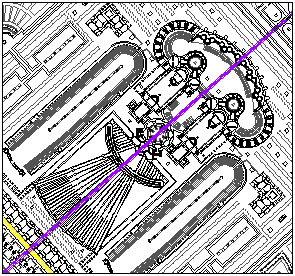
The Bustum Hadriani with its crematoriums and funereal banqueting halls, moreover, is nothing less that a gigantic "machine" to facilitate the passage from this life to the next. Yet, for all its architectural bombast, the Bustum Hadriani can in no way compete with the exalted simplicity of the tiny unnamed structure, which is behind the nymphaeum on the bank of the Tiber and at the very tip of the axis of life.
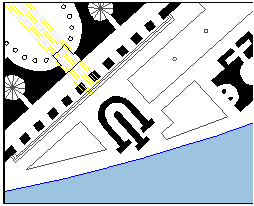
| |
1997.08.16
Redrawing History - fertilized architecture
...begin the analysis of the Campo Marzio as fertilized architecture with the Porticus Neronianae. The plan itself is like the proverbial missing link because it has both the traditional and the new geometric state all in one design. There is also the solid/void issue which leads directly to the intercourse building in terms of inside/outside, figure ground, penis/vagina, male/female.
...there are references to fecundity in Tafuri, Wilton-Ely, and Fasolo.
Did Piranesi's own imagination itself reach a new "fertilized" state--a state where creative manifestation began to occur exponentially rather that merely linearly?
genetic 1 a : relating to or determined by the origin, development, prior history, or causal antecedents of some phenomenon : CAUSAL, HISTORICAL, EVOLUTIONARY b : based on or determined by evolution from a common source -- used esp. of relations among languages or among words and grammatical forms of languages c : concerned with or seeking to explain, interpret, or understand (as a literary or psychological phenomenon) in terms of its origin and development or of its causal antecedents 2 : of or relating to genetics : characterized or produced by processes of genetics
genetic 1 a : a branch of biology that deals with the heredity and variation or organisms and with the mechanisms by which these are effected 3 : GENESIS
1997.09.21
The Longest Axis / The Axis of Life
1997.11.20
sex, Mars, reenactment
...the phrase, "back to daddy's balls, architecture halls"... ...a connection between this line and the Ichnographia. ...Mars being the father of Romulus--the founder of Rome, and the connection of sex and conception within Templum Martis as generators...
...the prominence of Mars... ...Piranesi actively redesigned Imperial Rome as he came to understand it. Piranesi assimilated all the knowledge about this part of the city, and through that assimilation he delineated an optimal synthesis. Piranesi's plan of the Campo Marzio is not an architectural reconstruction, but an archeological redesign. Piranesi's plan is not a rendition of what was, rather a rendition of what could have been. Piranesi's plan is not a reconstruction, but an historical reenactment.
The Ichnographia is a powerful reenactment of the architectural history of the Campo Marzio. The history, moreover, is not limited to Imperial Rome. Although the buildings are named for those primarily of the late Empire, Piranesi also very cleverly and extremely subtlely reenacts the architectural history of the Campo Marzio beyond the Imperial Age, specifically the inversion/conversion of Rome from pagan state to Christian state.
The opening stage for the reenactment is the Scenographia (whose very title has obvious theatrical connotations)...
...regarding the Ichnographia as a stone fragment: a reenactment of the Forma Urbis--a virtual reenactment of discovering the great missing piece of the "puzzle" that will bring all the other piece to a grand cohesion. (...here reminded of Tafuri's opening comments to The Sphere and the Labyrinth: "There comes a moment (though not always) in research when all the pieces begin to fall into place, as in a jig-saw puzzle, where all the pieces are near at hand and only one figure can be assembled (and thus the correctness of each move be determined immediately)..."
1998.01.11
life, death, and the triumphal way [inversion]
I spoke with Sue Dixon yesterday and told her of my latest "discoveries" regarding the life and death axes of the Ichnographia, the arch of Theodosius et al and the further symbolism of the Porticus Neronianae as an inverted basilica-cross. She too became excited by my discoveries and then also brought further insight, especially in reference to the issue of the papacy and its research during the eighteenth century into the early Christian Church. She spoke of Bianchini and his nephew (a contemporary of Piranesi's) and their dual volumes of pagan (Roman) and Christian art, and she also mentioned how the papacy of the eighteenth century had lost (more or less by force and financial restraints) much of its political power and thus took on a very pious role--exhibiting not its worldly power but its almost mystical or spiritual power.
What I was saying about the apparent Pagan-Christian conversion-inversion narrative of the Ichnographia fit with what research Sue is continually doing regarding the contemporary and early eighteenth century influences on Piranesi and the whole issue of proto-archeology - history of the eighteenth century.
After speaking with Sue, I began thinking of the significance of the arch to the victory over Judea that is situated to the western end of the Bustum Hadriani. I now see it related to the pagan-Christian conversion-inversion of Rome, but in terms of Roman history it is a somewhat marginal issue-event. Yet, in terms of Christianity, the Roman victory over Judea, and hence the fall of Jerusalem, is a significant, albeit still sorrowful, event because of this event's relationship, and indeed verification of certain-particular passages of New Testament Scripture, i.e., Jesus' answering the Apostles question of when Jerusalem would end (which I think is in Mark or the Acts of the Apostles). Seeing how a seemingly minor event in Roman (Imperial) history can at the same time be a critical event for the foundation of Christianity made me think about how the Roman Judaic victory unwittingly gave manifest confirmation that Christianity had from that point forward absorbed Judaism.
Although it comes from the margin or edge, the significance of the victory of Judea arch sheds a major light upon the narrative Piranesi tells--Piranesi's "story" is about Christianity's similar absorption and concomitant destruction of paganism. This notion of Christianity absorbing both Judaism and paganism has major theological implications, especially with regard to a heretofore perhaps ignored importance-significance of Rome and the Roman Empire within the Canon and doctrine of the Christian (Catholic) faith.
...the real axis of St. Peter's Basilica and Square. This axis is fundamental to Piranesi' axis of life--and the most significant point alone the existing axis is the burial place of St. Peter, which, although not noted in the Ichnographia, is nonetheless an ancient Roman artifact.
...the story of the Triumphal Way. ...follow the triumphal path on the plan, and explain the entire route in Roman-pagan-triumphal ritual terms. ...bring up the essential concept of reenactment, the reenactment that Piranesi here designed, especially the well planned sequence of stadia and theaters along the way. Piranesi made use of what was actually once there.
When the route reaches the wall at the Temple of Janus, attention turns to Triumphal Arch-Gate, which is closed during the years of inactivity. Does the Triumphal Way then bounce off the wall and go back the way it came? Does the Temple of Janus allow us to go in either direction? (Other clues of inversion abound: obelisk in the Horti Salustiani, Porticus Phillippi, the Arches along the Via Lata, the Via Flaminia, the Circus Flaminia, the obelisks at Augustus's Tomb. The recurring inversion theme points to a greater meaning/symbolism.) The Temple (arch) of Janus represents the Arch of Janus built by Constantine (who might himself be called the Janus figure of Christianity) and this is the initiation of the way of Christianity's triumph: the profane to the sacred; the forest, hell, purgatory, heaven; the path of salvation through Christ and the Church.)
...the way from the profane to the sacred ends at the Area-Templum Martis as symbolic of the union of the most sacred site ancient Rome (or at least its point of origin) with the most sacred site of Christian Rome (St. Peter's place of burial) and also the point of origin of Christian Rome.
The garden of Nero is the ultimate field of inversion: Horti Neroniani to Vatican City, the garden of antichrist to the Church as the Body of Christ, the foremost seat of the Church of Christ, and finally St. Peter's inverted crucifixion begins the conversion of Rome.
I will conclude the inversion from pagan to Christian story-line by returning to the axis of death and the Arch of Theodosius et al at its tip, and thus when compared with the intercourse building we have depicted the beginning and the end of pagan Rome. To this I will add the Jewish Victory monument and end with the notion that Piranesi has here used architectural plans and urban design to tell the "history" of ancient Rome, however, one has in a sense read both the "positive" and the "negative" image-plan -- a story where the first half is the reciprocal of the second half (and vice versa). (I am oddly reminded here of the double theaters story from Circle and Oval in St. Peter's Square.)
| |
1997.12.28
axes of life and death
...the Roman cardo and decumanus... ... wonder whether the life and death axes of the Campo Marzio are also a reenactment of the ancient town planning axes. Upon inspection of the Ichnographia, the life and death axes are just a few degrees shy of corresponding with the cardinal points. Moreover, the cardo, the north-south axis corresponds to the axis of death in the Ichnographia, and traditionally "refers to the axis around which the universe rotates." The Campo Marzio axis of life, the east-west axis, the decumanus, refers to the rising and setting of the sun.
...the Arch of Theodosius et al is placed at the tip of the axis of death. In its smallness (and apparent insignificance) it reminds of the tiny unnamed intercourse building at the tip of the axis of life. What is of utmost significance, however, is that this particular Triumphal Arch is indeed one of the very latest building additions rendered within the Ichnographia, and dates from anywhere between AD 367-395.
The placement of this arch at the tip of the axis of death is symbolic in that it represents the very end--Theodosius was the last Emperor to rule over both the East and West Empire, and it was he who instituted Christianity as the state religion--the end of the pagan empire and the end of any semblance of a totally unified empire. Thus, the intercourse building at the tip of the axis of life represents the very beginning (of life and quite possibly of the Ichnographia's plan formations, as well) and the Arch of Theodosius et al at the tip of the axis of death represents not only Rome's end as the sole capital of the civilized world, but also its end as capital of the pagan world.
It is through his plan of the city of Rome that Piranesi writes (and/or rights) the history of Rome itself. Through the Ichnographia Piranesi reenacts the history of the city.
...the Ichnographia represents Rome at its pagan zenith...
1998.02.19
"The Key Plan"
"The Key Plan"... ...about the tiny unnamed intercourse building at the end of the axis of life.
...unlocking secrets, gaining access to knowledge.
...the plan as depicting conception, and therefore the intentional starting point for meaning (and hence interpretation as well).
...the symbolism regarding the conception of Romulus and Remus--Mars and the royal Vestal Virgin as the parents.
...the tiny plan as the generator of all the subsequent plans; the beginning of the "embryonic development" of all the other plan formations.
...the signifying effect of inside vs. outside and of solid vs. void.
...the irony that Bloomer's key plan is just across the river and the unfortunate non-starter nature of her interpretation and underworld scenario.
...the connection to the The City of God regarding the fratricide of Romulus towards Remus and its parallel to Cain and Abel.
1999.01.29
eros et thanatos
1999.08.19
ideas
6. the Metae Sudantis near the key [Aedicula Intercourse], yet near the Arch of Constantine in actuality...
2000.12.21
errors in "speaking architecture"
...a "display [that generally] deals with the 'language' and meaning of architectural planimetric forms, while specifically [displaying] the 'master key' that unlocks the long held mysteriousness of Piranesi's Ichnographia Campus Martius. ...you see a 'building' [Aedicula Intercorse] that is both literally and figuratively conception. This tiny building is indeed one of the few plans within the Ichnographia that Piranesi does not provide with a Latin label, and that is because the building, through its plan, already speaks for itself, and, moreover, it speaks of all the 'concepts' there involved, namely, Piranesi's conception of architectural language, and the very conception of Rome [Romulus] itself. Piranesi's architectural intensification here is so tight to the point that indeed the medium is the message.
Essentially, Piranesi designed a building deliniating conception, which also represents Piranesi's conception of the large Campo Marzio plan, which also represents the beginning/conception of Rome itself.
2001.11.26
Piranesi's Continual Double Theaters
2003.08.14
Campo Marzio and Philadelphia
2003.09.12 10:40
Re: more news from Philadelphia's Logan Circle
I returned to the Benjamin Franklin Parkway to continue virtually walking along the Campo Marzio long axis from Hadrian's Tomb to the tiny 'intercourse' building along the banks of the Tiber.
The most thought/memory provoking Memorial around Logan Circle is the one dedicated to the Colored Soldiers" who fought in World War I. Remember, the Parkway was executed between the two World Wars. There it is, literally etched in stone, the description of "Colored". Otherwise, it is a very handsome memorial, and evokes an enormous amount of respect.
I am somewhat surprised at the predominate amount of military/soldier memorials within/along the Benjamin Franklin Parkway, and I can't help but see how this all relates perfectly to the Campo Marzio, since the original Field of Mars is exactly were ancient Roman soldiers used to exercise. I [re]read the other night, in Building The City Beautiful: The Benjamin Franklin Parkway and the Philadelphia Museum of Art, how the site of the Parkway, after demolition of the many previously occupied city blocks but before ultimate construction, was used briefly by troops before going to battle in Europe.
Lots of pictures were taken at and around Logan Circle before walking the rest of the axis toward the LOVE sculpture at JFK Plaza (now popularly referred to as "Love Park"). This part of the Parkway is integral to the city proper, thus tall buildings and regular pedestrians (half using cell phones) are in abundance--this contrasts with the Parkway north of Logan Circle, which is several large blocks of mostly open lawn. Just before reaching JFK Plaza, there is the Memorial dedicated to Holocaust Victims, on the Parkway since 1964. In the warmer months, the whole length of the Parkway (on both sides) is lined with the flags of the all the nations of the world--I believe this was started in the late 1970s. The nations are presented in alphabetical order, except the flag of Israel is next to the Holocaust Memorial, just like the flag of the Vatican is next to the Basilica of Sts. Peter and Paul.
John F. Kennedy Plaza/Love Park is one of Philadelphia's 'living rooms', and the Robert Indiana LOVE sculpture has been there (I believe) since the Bicentennial/1976. At first just a temporary installation signifying the meaning of Philadelphia--City of Brotherly Love, the sculpture became an endeared feature of the city and was thus made permanent. When I first took pictures of LOVE in October 2001, a newly engaged couple asked me to take a picture of them in front of the sculpture--the resultant picture was to be part of their Engagement Announcement. During the 1990s, Love Park became notorious as a preferred venue for skateboaders [indeed actually famous in overall skateboarding folklore]. Lots of damage was done, and skateboarding here is now prohibited--although I think special/official skateboarding competitions are still conducted here.
2005.11.10 10:38
It rocked Eisenman in his chair...
My opinion of Bloomer's book, as far as it relates specifically to reading Piranesi's Ichnographia of the Campo Marzio, is that it is indeed wrong and [somewhat] trite--almost all of what Bloomer writes about the Ichnographia is taken virtually verbatim from Tafuri; she does, however, include some original material relative to the "pit of the underworld" citing it as the entry way into understanding the Ichnographia as a labyrinth, but she misses the real key to the large plan (the tiny intercourse building) which is directly across the Tiber from the pit. Bloomer's book may be fun, but it is not good scholarship in that she really did not come to read and understand the whole plan at all--she went on to seek meaning "underneath" the plan while what she really did was avoid the actual plan itself. Can you honestly say that you now know what the Ichnographia is about after reading Bloomer's book?
|